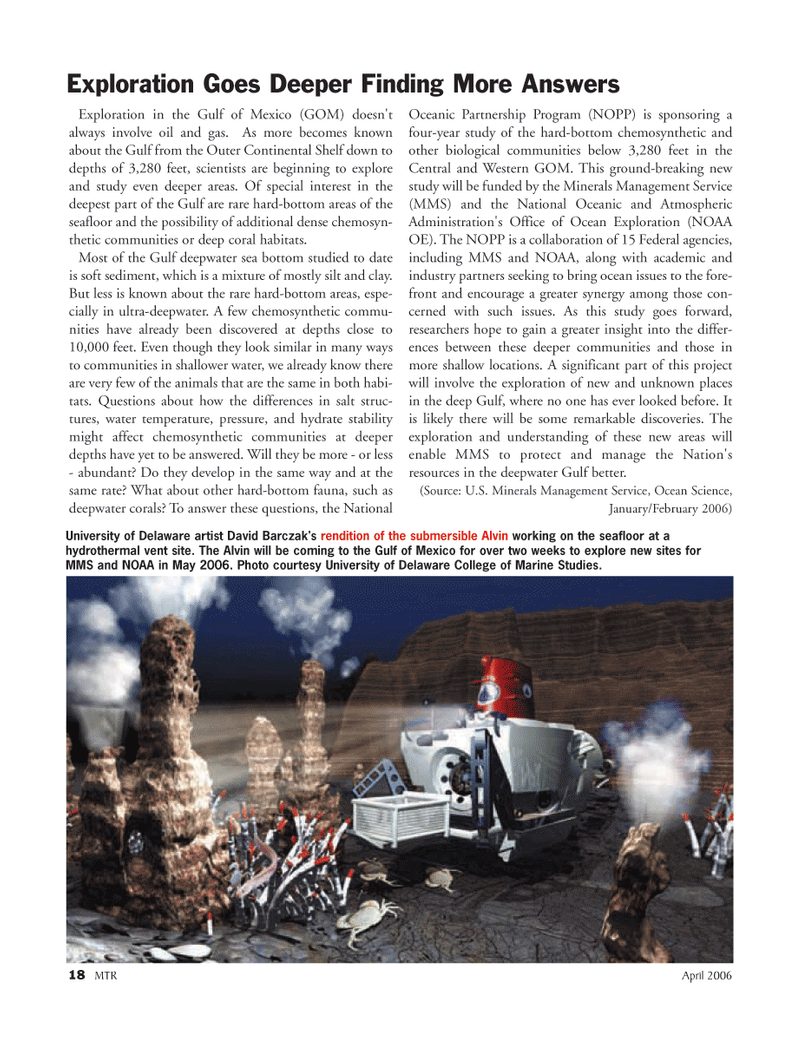
Page 18: of Marine Technology Magazine (April 2006)
The Offshore Technology Edition
Read this page in Pdf, Flash or Html5 edition of April 2006 Marine Technology Magazine
Exploration in the Gulf of Mexico (GOM) doesn't always involve oil and gas. As more becomes known about the Gulf from the Outer Continental Shelf down to depths of 3,280 feet, scientists are beginning to explore and study even deeper areas. Of special interest in the deepest part of the Gulf are rare hard-bottom areas of the seafloor and the possibility of additional dense chemosyn- thetic communities or deep coral habitats.
Most of the Gulf deepwater sea bottom studied to date is soft sediment, which is a mixture of mostly silt and clay.
But less is known about the rare hard-bottom areas, espe- cially in ultra-deepwater. A few chemosynthetic commu- nities have already been discovered at depths close to 10,000 feet. Even though they look similar in many ways to communities in shallower water, we already know there are very few of the animals that are the same in both habi- tats. Questions about how the differences in salt struc- tures, water temperature, pressure, and hydrate stability might affect chemosynthetic communities at deeper depths have yet to be answered. Will they be more - or less - abundant? Do they develop in the same way and at the same rate? What about other hard-bottom fauna, such as deepwater corals? To answer these questions, the National
Oceanic Partnership Program (NOPP) is sponsoring a four-year study of the hard-bottom chemosynthetic and other biological communities below 3,280 feet in the
Central and Western GOM. This ground-breaking new study will be funded by the Minerals Management Service (MMS) and the National Oceanic and Atmospheric
Administration's Office of Ocean Exploration (NOAA
OE). The NOPP is a collaboration of 15 Federal agencies, including MMS and NOAA, along with academic and industry partners seeking to bring ocean issues to the fore- front and encourage a greater synergy among those con- cerned with such issues. As this study goes forward, researchers hope to gain a greater insight into the differ- ences between these deeper communities and those in more shallow locations. A significant part of this project will involve the exploration of new and unknown places in the deep Gulf, where no one has ever looked before. It is likely there will be some remarkable discoveries. The exploration and understanding of these new areas will enable MMS to protect and manage the Nation's resources in the deepwater Gulf better. (Source: U.S. Minerals Management Service, Ocean Science,
January/February 2006) 18 MTR April 2006
Exploration Goes Deeper Finding More Answers
University of Delaware artist David Barczak's rendition of the submersible Alvin working on the seafloor at a hydrothermal vent site. The Alvin will be coming to the Gulf of Mexico for over two weeks to explore new sites for
MMS and NOAA in May 2006. Photo courtesy University of Delaware College of Marine Studies.
MTR#3 (17-32).qxd 4/7/2006 11:26 AM Page 18

 17
17

 19
19
